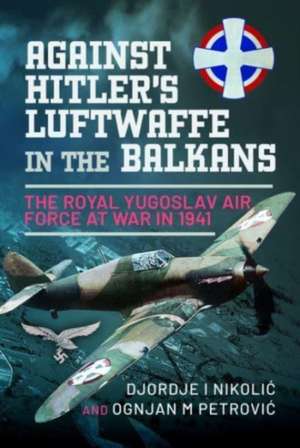Against Hitler's Luftwaffe in the Balkans
Autor Djordje I Nikoli?, Ognjan M Petrovi?en Limba Engleză Hardback – 19 sep 2023
In 1929 the monarchy changed its name to the Kingdom of Yugoslavia. Then, from 1930, the official name of the air service branch its military was changed to what is commonly known in the West as the Royal Yugoslav Air Force (RYAF). The obsolete First World War aircraft were replaced from 1925 onwards by stop-gap solutions purchased mainly from France, some from the Czechoslovakian Republic as well as from the first domestic factories.
From 1936, the RYAF again began to reorganize and modernize, with the purchase of the most modern aircraft available at that time. These aircraft were imported from the UK, Germany and Italy, some being built under license in domestic factories. During this period the Kingdom of Yugoslavia succeeded, as much as conditions allowed, to equip its air force with the most advanced fighter and bomber types of the period.
For the Kingdom of Yugoslavia, the Second World War started on 6 April 1941. The military coup d'etat of 27 March 1941 and anti-German demonstrations in Belgrade clearly aligned the kingdom with the Allies. That same day, Hitler ordered the implementation of Unternehmen 25 (Operation 25) - the attack against Kingdom of Yugoslavia. Hitler had also secured Mussolini's support for this campaign, while Hungary, Romania and Bulgaria gave active or passive backing in exchange for territorial claims in Yugoslavia.
Despite all the odds, the airmen of the RYAF fought gallantly in the defense of their homeland, with fighters taking on the German and Italian bombers and their escort fighters - including the Axis types in service with the RYAF.
Eventually, due to the deteriorating situation on the front and the ever-increasing risk of the king and his government being captured, the decision was taken to evacuate by air to Greece. In the summer of the 1941 some 220 Yugoslav aviators gathered in Egypt and continued the fight against Axis, this time in the colors of the RAF. This is the full story of their service and combats in the early months of that year.
Preț: 172.99 lei
Nou
Puncte Express: 259
Preț estimativ în valută:
33.10€ • 34.72$ • 27.56£
33.10€ • 34.72$ • 27.56£
Carte disponibilă
Livrare economică 11-25 martie
Livrare express 25 februarie-01 martie pentru 46.98 lei
Preluare comenzi: 021 569.72.76
Specificații
ISBN-13: 9781399088978
ISBN-10: 1399088971
Pagini: 232
Ilustrații: 250 mono integrated
Dimensiuni: 254 x 180 x 25 mm
Greutate: 0.84 kg
Editura: Pen & Sword Books Ltd
ISBN-10: 1399088971
Pagini: 232
Ilustrații: 250 mono integrated
Dimensiuni: 254 x 180 x 25 mm
Greutate: 0.84 kg
Editura: Pen & Sword Books Ltd
Notă biografică
DJORDJE NIKOLIC was born in Belgrade, Serbia, coincidentally on National Aviation Day. Since early childhood he has been fascinated by all aviation-related matters, always staring up in the sky and regularly visiting aviation themed museums across Europe. His interests are primarily in the Royal Yugoslav Air Force and the history of Belgrade in the period between the two world wars and his collection includes hundreds of original photographs, documents, pilot logbooks and other memorabilia. Djordje graduated in mechanical engineering from the University of Applied Sciences in Aachen, Germany. Having completed his studies in the German language, he was able to research and interpret historical documents relating to the German aircraft in Yugoslav service in the interwar and Second World War period. He is also an avid aircraft modeler and regularly attends local and national shows and contests. Djordje currently resides in Washington State, USA.
